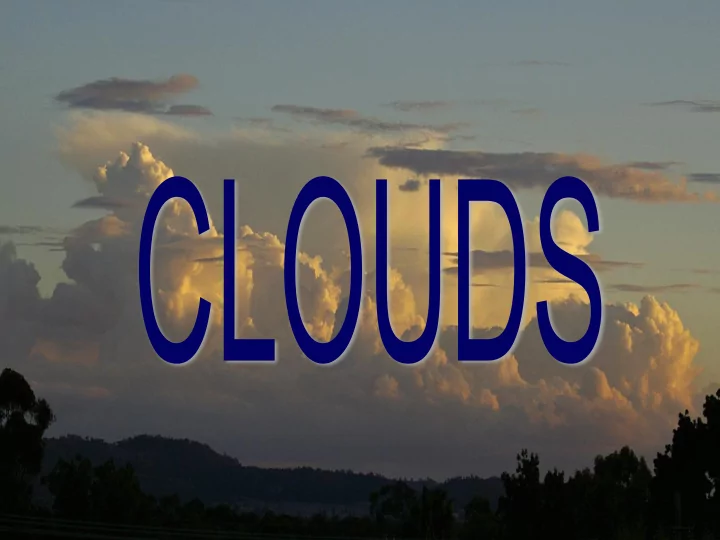

Compare daily and seasonal changes in weather conditions (including wind speed and direction, precipitation, and temperature).
There are three basic types of clouds: stratus, cirrus, and cumulus. All other clouds are a combination of these three. How can these cloud types be used to predict the weather? Write a prediction for this question in your notebooks. I think that clouds can be used to predict weather because...
Clouds form when warm air rises and cools. Clouds form when air Clouds are made of tiny drops of water or rises and cools .Clouds ice crystals. These drops stick to dust and are made of tiny drops of other tiny particles in the air. Clouds can water. These drops stick look different depending on what they are to dust and other tiny made of. If a cloud is very thick, it may particles in the air. look gray or even black. That is because the sunlight can’t pass through it. Clouds produce precipitation. The 4 main types of precipitation are rain, snow, sleet and hail.
These clouds are formed when a mass of warm air is slowly pushed up over a mass of cooler air or over a mountain. Stratus means “layer,” and these clouds form layers, like a blanket. These clouds can produce rain or snow.
On clear days when the surface of the earth cools more quickly, a stratus cloud or fog will form close to the ground.
These clouds form when large bubbles of warm air rise rapidly into the atmosphere. Cumulus clouds are puffy clouds that have a flat bottom. Small white cumulus clouds mean fair weather.
Cumulus clouds look like pieces of floating cotton in the sky. Although these clouds usually mean fair weather, if they start to look gray you can expect light rain or snow showers.
Cirrus clouds form high in the sky. They look thin and you can see through them. They are made mostly of ice crystals.
Cirrus means “curl of hair” . Cirrus clouds usually mean good weather. However they may signal a that a change in weather conditions is coming.
Cumulonimbus clouds are big dark tall cumulus clouds that bring thunderstorms. These clouds develop upward. They can start as low clouds and reach up to the highest clouds.
Cumulonimbus Clouds can also produce a hail storm.
If rain or snow falls from a cloud, the term nimbo- for “rain” - is added to the clouds name. Ex. Nimbostratus, cumulonimbus Clouds can also be grouped into families by their height in the atmopshere. There are low clouds, middle clouds, and high clouds. Since cumulonimbus clouds develop upward, they are known as clouds of vertical development.
High clouds - cirro Ex. Cirrocumulus, cirrostratus, cirrus Middle clouds - alto Ex. altoculumus, altostratus Low clouds - strato Ex. stratocumulus, nimbostratus, stratus
Let’s predict the weather!
What kind of weather is associated with a stratus cloud? A. thunderstorm B. Rain or snow C. Fair weather
What kind of weather is associated with a cirrus cloud? A. Usually fair weather, but it may rain or snow. B. Thunderstorm C. Blizzard
What do cumulus clouds usually mean? A. Snow storm B. Hailstorm C. Fair weather
What kind of weather does cumulonimbus clouds bring? A. Fair weather B. Thunderstorm C. Light rain or snow
Video - Why Do Clouds Stay Up Video - All About Clouds
References and websites http://www.schoolscience.rice.edu/duker/weatypeclouds.html http:www.urbanext.uiuc.edu/weather/2html http:www.weatherstock.com/hailcat3.html http:www.danheller.com/images/California/GoldenGate/fog/img18.html http://quatr.us/physics/weather/cumulus.htm
Recommend
More recommend